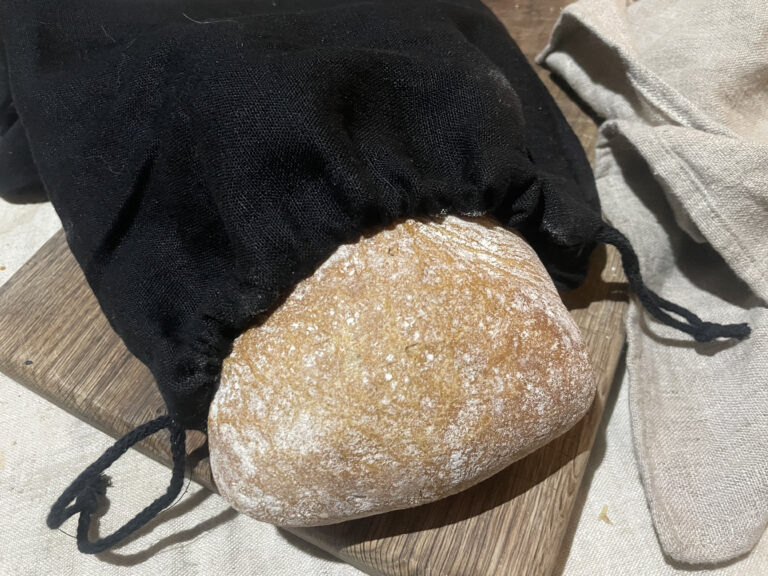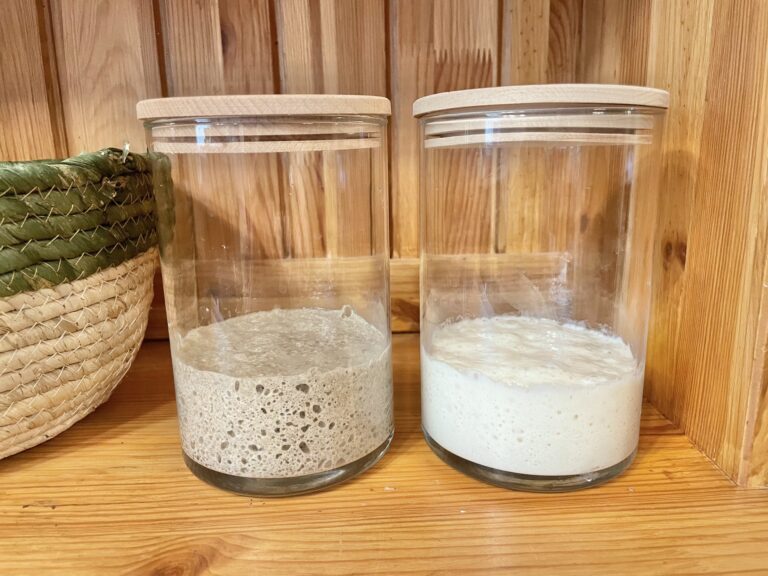It’s safe to say that dish towels are a staple in every household. There’s always one hanging on a hook or draped over the stove handle for drying hands or cleaning up spills. Truth be told, I often use my apron to dry my hands, and my husband, well, he’s always wiping his hands on my apron!

Before starting, come and follow me on Instagram, Facebook, and Pinterest!
I frequently change kitchen towels because I believe they should always be as clean as possible. It’s also good to have separate towels for drying dishes and hands. I think the dish-drying towel should be super clean.
How Often Should You Change Kitchen Towels?
There’s no one-size-fits-all answer. If you happen to wipe milky fingers on the towel, you can bet it’s only a matter of hours before nasty bacteria start breeding in the fibers. Generally, I change towels every few days, sometimes less often, and sometimes even more frequently. It’s not a good practice to use the same kitchen towel week after week and wait until the center of the towel starts to darken.
Different Uses for Kitchen Towels
Here’s a simple list of how I’ve used kitchen towels. First and foremost, of course, for drying hands. Sometimes, though, I’ve used a towel as a pot holder or a hot pad. When you take freshly baked rye bread out of the oven, it’s good to have a clean hand towel to place over it. And finally, here’s a slightly extreme example: when I unexpectedly ran out of cloth diapers, I resorted to using a kitchen towel… but I’ve also used a T-shirt.
Why Sew Your Own Kitchen Towels?
Without a doubt, sewing your own kitchen towels pays off financially, even if you use high-quality fabric. Kitchen towels also make great gifts. You can keep a stack of towels ready on the shelf, and when someone needs a gift, it’s a great way to bring joy to someone. Making a kitchen towel is a fun project for a beginner sewer since you can make it just with basic sewing skills. While all the sewing projects on this blog are ones that any homemaker or hobbyist can handle, making a kitchen towel is undoubtedly one of the simplest projects and you can do it even if you sew first time in your life. What’s especially nice is that it’s a fun activity you can do with a child, and why not use this simple project as part of homeschooling materials? And since making a towel doesn’t take long, the child won’t get tired before it’s done.
What Material Makes a Good Kitchen Towel?
My short answer is natural material (linen or cotton), and the fewer “dubious” colors, the better! If I were to explain further, I find that natural material is good because it can absorb a lot of liquid, and linen, for example, dries super fast! At least, I have a terrible habit of drying my hands in the towel without shaking them first, and I wash my hands too much while cooking (even the doctor said I wash them too much!), so that’s why I have multiple towels in the kitchen because they’re always soaking wet. A quick solution is to have several towels, but a more thorough solution is to eliminate strange habits. But let’s not digress from the topic and let’s start sewing!
Things You’ll Need
Sewing machine
Hot iron – optional (for hemming)
Fabric – the size of the fabric for one towel should be about 15 inches x 15 inches, but use your desired length.
Thread – the same color as the fabric
How to Make a Hanging Towel
- Cut out the towel to your desired size. You can also make towels of different sizes, which would look visually very interesting when hung side by side in the kitchen. For this design, I recommend a square towel. While the size of the towel may not be crucial, still consider that for hemmed edges, you should leave a seam allowance of at least 0.6 inches.
- Cut out a tiny strip of fabric for the hook: about 3 inches long and 1 inch wide.
- Sew the hook. To do this, fold the edges in and sew them from the top. You don’t have to sew the ends because we’ll hide them in the work.

- Before you start hemming the edges, hem all the corners of the towel. You can find detailed instructions for hemming corners in this post.
- Hem all sides of the towel, but leave about 1-2 inches of the corner unhemmed, as we’ll attach the hanging hook there. make sure you make a hem on the wrong side of the fabric.
- As last steps, place the hook in the corner of the towel and sew the hem to the end.
- Your towel is now ready!

Ideas and Tips
- Don’t sew all towels in the same color. Visually, it looks beautiful when towels are of the same style but with slightly different shades: for example, white, gray, and brownish.
- Make sure you use quality fabric that hasn’t been dyed with harmful chemicals. If the towel gives off a strong color when washed, it’s probably a bad sign. You probably don’t want your food or hands coming into contact with such substances while using.
- If you want, you can use a cotton cord as the hanging hook. I think a macrame cord would be perfect for this.
- Use your creativity and come up with more fun designs for making kitchen tea towels and adding spice to your kitchen decor. You can also sew together any leftover scrap fabric pieces.
- You can also add crocheted embellishments with a really small extra cost and additional time. How about some flowers on top of the towel or a beautiful lace on the bottom of the towel?
- If you are a beginner seamstress, you may want to do a basting stitch while hemming before you start sewing.
- To make the towel design even more interesting, you can sew button holes onto the towels and hang them on a hook using a ribbon with the button.

I hope you found inspiration from this post for sewing beautiful hand towels, and once you’ve embarked on this task, all your friends and acquaintances will likely receive the hand towels as cute handmade gifts. Sewing hand towels is just such a simple and relaxing activity that doesn’t require much mental effort, and the chances of failure are extremely low. You don’t have to use a store-bought kitchen towel never again!

Simple and Fast DIY Hanging Kitchen Towel Tutorial
Sewing hand towels is just such a simple and relaxing activity that doesn't require much mental effort, and the chances of failure are extremely low. you must never use a store-bought kitchen towel again!
Materials
- Thread
- Fabric (linen or cotton)
Tools
- Sewing machine
- Hot iron (optional)
Instructions
- Cut out the towel to your desired size. You can also make towels of different sizes, which would look visually very interesting when hung side by side in the kitchen. For this design, I recommend a square towel. While the size of the towel may not be crucial, still consider that for hemmed edges, you should leave a seam allowance of at least 0.6 inches.
- Cut out a tiny strip of fabric for the hook: about 3 inches long and 1 inch wide.
- Sew the hook. To do this, fold the edges in and sew them from the top. You don't have to sew the ends because we'll hide them in the work.
- Before you start hemming the edges, hem all the corners of the towel. You can find detailed instructions for hemming corners in this post.
- Hem all sides of the towel, but leave about 1-2 inches of the corner unhemmed, as we'll attach the hanging hook there. make sure you make a hem on the wrong side of the fabric.
- As last steps, place the hook in the corner of the towel and sew the hem to the end.
- Your towel is now ready!





